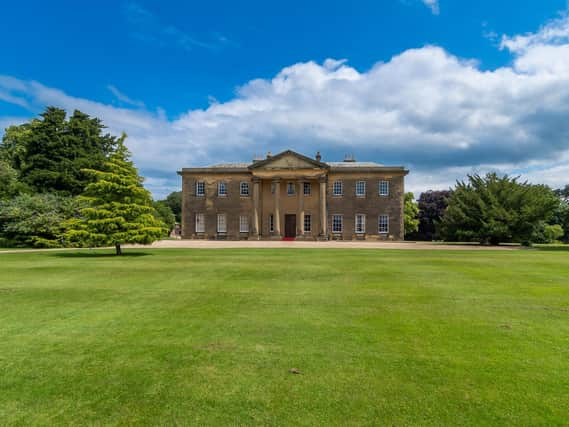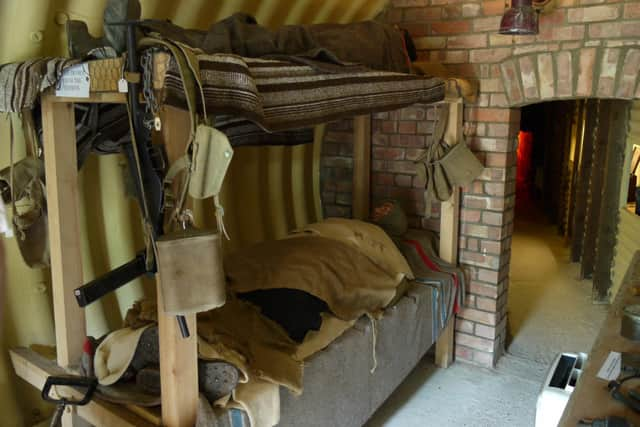Researchers' last push to find lost bunkers used by Yorkshire's Resistance agents in World War Two - after a year of lockdown discoveries


The Coleshill Auxiliary Research Team dedicate their time to uncovering the lost bunkers used by Britain's underground Resistance operatives, who would have been our covert line of defence if a Nazi invasion had been successful.
There were 300 such men working for British Auxiliary Unit patrols in Yorkshire, concentrated mainly on the coast - and most took a vow of silence that lasted a lifetime.
Advertisement
Hide AdAdvertisement
Hide AdDuring 2020, the volunteers received a record number of calls and tip-offs thanks to an increasing number of people either spending time outside walking in the woods and quarries where the unit's hidden shelters were built, or searching through deceased relatives' possessions during lockdown.


The CART members have now urged as many people as possible who think their forebear may have served in the Resistance to come forward before their stories are lost forever.
There also remain undiscovered bunkers dotted around the countryside. In Yorkshire, there is only one operational base which has not been found - that of the Wharram le Street patrol, which protected the Driffield to Malton railway line that supplied several airfields, as well as Castle Howard. Although the seven members of the patrol have been identified, the bunker they operated from has never been located.
Volunteers are also keen to trace images of a collapsed bunker used by the Flixton patrol, which was sited at Flixton Brow, a small wood near Scarborough. Despite being on public land, few visible signs of it still remain and records of its condition are not known to exist.
Advertisement
Hide AdAdvertisement
Hide AdWhile the majority of BAU veterans have now passed away, a second living agent came forward after a CART appeal was featured in The Daily Telegraph earlier this month, and there may be more finally prepared to speak in their last years.
As CART's press officer Andy Chatterton puts it, the men who were later revealed to be BAU agents were those who may have initially appeared to have 'not done very much in the war'. They were young - no rag-tag Dad's Army - and mainly in reserved occupations, such as farming.
In Yorkshire, there was an entire patrol consisting of staff from the Blackburn aircraft factory in Brough - today run by BAE Systems. Gamekeepers were recruited, and found secret hideouts on their employers' country estates to use as nerve centres and explosives stores. Railway workers also joined the BAU.
What these men had in common was an intimate knowledge of their local area, and possibly a frustration at being seen to be ostensibly sitting out the war at home. They were highly trained, sophisticated, fit and had a ruthless streak - if the Germans had arrived, it would have been the Resistance who would have assassinated the 'weak links' who could have given away vital intelligence under interrogation. Many of these targets were policemen, schoolteachers and even the BAU's own senior officers. Often they were just innocent local people who had stumbled across BAU exercises and bunkers by accident.
Advertisement
Hide AdAdvertisement
Hide AdTheir main tasks, however, were to work at night to disrupt enemy activity such as transport and supply lines. Their life expectancy was just two weeks. If an invasion had happened, they would have simply vanished into the night, without telling their families where they were going, and taken shelter in their concealed posts.
According to Mr Chatterton, many BAU veterans kept up the pretence of innocence even into their 90s, despite the Official Secrets Act they signed expiring after 50 years and the CART researchers publishing lists of each patrol's members online. One man who was proven to have served with the unit denied it outright until his death.
"We have to work off rumours and folklore. Often, these men told their relatives that they had served in a 'special Home Guard' and were people who seemed to have done little more than farm during the war - but may have kept an unusual number of knives and explosives. These can be our best clues.
"In 1944, when the unit was stood down, they all received a letter of thanks and a lapel badge, but there was no official recognition. These badges often turn up in Granny's button box or at the back of drawers.
Advertisement
Hide AdAdvertisement
Hide Ad"We formed the research group 10 years ago, but 2020 has been by far our best year for leads. We had 14 new tips after the Telegraph appeal - including a 96-year-old veteran who came forward. We had thought there was only one left. For him, it is his last chance to speak about it.
"People have been outdoors more, or at home clearing things out. We had a lot of new discoveries in 2020. There are also a lot of people who remember playing in bunkers they thought were air raid shelters in the 1950s or 60s,"
As many agents were from farming families whose descendants still work the same land today, CART volunteers have had lucky strikes from 'cold calling'.
"One new site we found in Devon because the farmer was on the list. The family were still there, so we called out of the blue and spoke to his daughter. She knew he had been in the Home Guard but not that he was this highly trained killer. Families had no idea."
Advertisement
Hide AdAdvertisement
Hide AdMr Chatterton points out that around 70-80 per cent of veterans honoured the terms of the Official Secrets Act even after a historian published a book about their activities in 1968. This has meant that there is a relatively untold story involving 4,500 men, and one which has contributed to an inaccurate portrayal of Britain as being underprepared for invasion.
Another reason for their reticence is likely to be that their 'kill list' of those to be disposed of could have placed them in awkward situations after the war ended.
"The civilian targets were people like the local policeman who had done the background checks on the suitability of the recruits, without knowing which unit they were joining - he would have known that these names were all operating in the same patrols. The intelligence officers who set the whole thing up would have been killed by their own men. Anyone who had found out about the unit by mistake would have been assassinated in case they gave information to the Germans.
"There is a case in Cornwall, where an elderly couple had a cottage that faced a copse where there was a BAU bunker. They had seen activity while they were gardening, and they would have been killed.
Advertisement
Hide AdAdvertisement
Hide Ad"And if you lived in a small village in Yorkshire, after the war you could easily end up in the pub having a pint with that same policeman whom you had been ordered to kill if we were invaded - so people kept quiet.
"Some of the targets were just busybodies, others pro-Nazi sympathisers - but you wonder how feuds and personal grudges may have come into it as well."
CART's detailed and comprehensive records provide a fascinating insight into the sort of men who were recruited into the Resistance - and the abandoned bunkers they left behind.
In Burton Agnes, the patrol was led by Sergeant Frederick Dixon, who had joined after a year spent as an air raid warden. Sergeant Dixon, who died in 1964, was the stationmaster at Burton Agnes Station - ideally placed to sabotage the railway line between Hull and Bridlington that could have been used by invading troops.
Advertisement
Hide AdAdvertisement
Hide AdA base was organised by the head gamekeeper on the Scampston Hall estate, near Malton. Lieutenant Henry Towse was also the commander of the wider group the patrol was part of, and he arranged for the ice house to be commandeered for them.
An escape tunnel was hacked out of the ice house wall, and inside are the remains of a stove grate and bunk bed frames big enough for two men each, as well as traces of telephone cable.
In Aldbrough, the sealed underground chamber used by the patrol is in woodland now used as a Scout campsite, while at Skeffling, near Withernsea, a bunker was built underneath derelict cottages on Wintersett's Farm - the closest observation point to Spurn Head.
The entrance was via a trapdoor concealed under a pile of bricks, with an escape tunnel running beneath one cottage to the scullery of the other. There were bunk beds, a toilet and a telephone line to the farm.
Advertisement
Hide AdAdvertisement
Hide AdIn Cottingham, on the outskirts of Hull, there were two patrols. One bunker was located in the grounds of Castle Hill Hospital, and the other was beneath the greenhouse of The Grange, a house which was demolished when Cottingham High School was built.
The members of patrols in Hull and Beverley are a throwback to the old industries in the area - rather than farming, they worked in shipyards or leather tanneries, Many were in white collar clerical jobs that seem unlikely to be classed as essential work, while others ran their own businesses or shops.
In Cottingham, a local doctor, John Lindsay, served - and managed to save his comrades' lives when he arrived late for a shift one night and found the rest of the patrol almost dead from suffocation in the bunker beneath The Grange's greenhouse. They had choked on fumes from the nearby boilerhouse, and he was able to revive them.
One of the most intact posts is at North Cave, where many of the agents were Blackburn aircraft fitters and draughtsmen. A sink, telephone wire and escape shaft can still be seen in the bunker, which was located in a small plantation. The entrance was concealed inside a tree trunk.
Advertisement
Hide AdAdvertisement
Hide AdThere is also a large bunker at Rise Hall, the mansion that became well-known when it appeared on the television series Sarah Beeny's Restoration Nightmares. Rise had been used as the headquarters of the whole East Riding division before they moved to Middleton Hall, near Driffield, after which the vacant Rise bunker was given to the local Skirlaugh patrol.
The bunker would have been much too large for the eight Skirlaugh men who used it, and it remains in good condition today.
The 45ft chamber has the original bed frames, two taps, water tanks and paint remaining. There is also a second tunnel that was used for ablutions and an escape shaft.
And what of the men of Yorkshire who finally spoke out?
Hornsea farmer Claude Varley was a teenage boy was he was recruited to Bewholme patrol, along with his two brothers. In 2013, Claude, then 90, outed himself in a Yorkshire Post interview. He had never told his parents or wife about his wartime activities, and his four children only well into his old age.
Advertisement
Hide AdAdvertisement
Hide AdMr Varley, who died in 2019, was chillingly candid about his motives for joining the Resistance - he was a 'wild boy' who was prepared to kill. He hid his manuals on guerrilla warfare in brochures from his agricultural feed suppliers, and went to Middleton Hall for covert training.
He was also given the names of three people - described as 'inquisitive' - whom he would be expected to shoot should the worst happen. He worked the family farm until he retired at 73 - and never disclosed the names on that piece of paper.
Contact the researchers at [email protected] if you have any information which may assist them.
Comment Guidelines
National World encourages reader discussion on our stories. User feedback, insights and back-and-forth exchanges add a rich layer of context to reporting. Please review our Community Guidelines before commenting.
